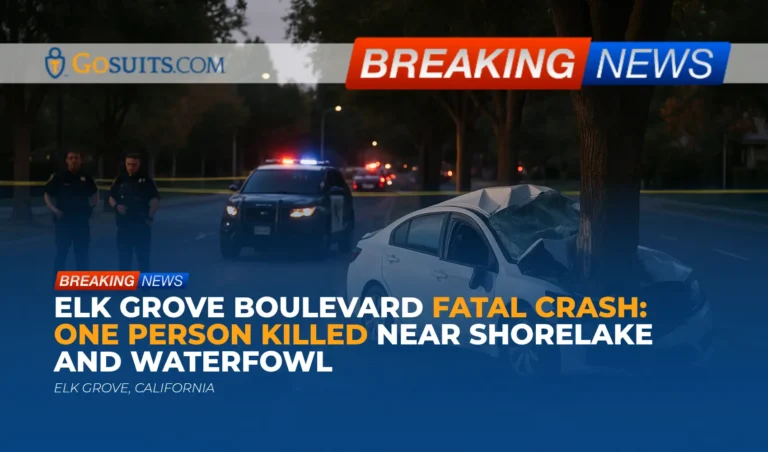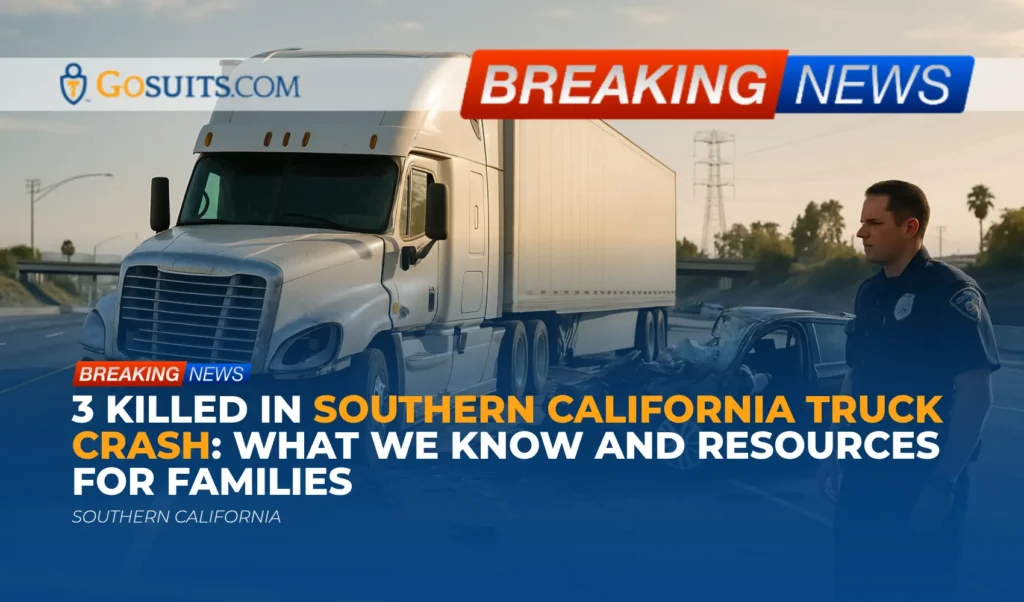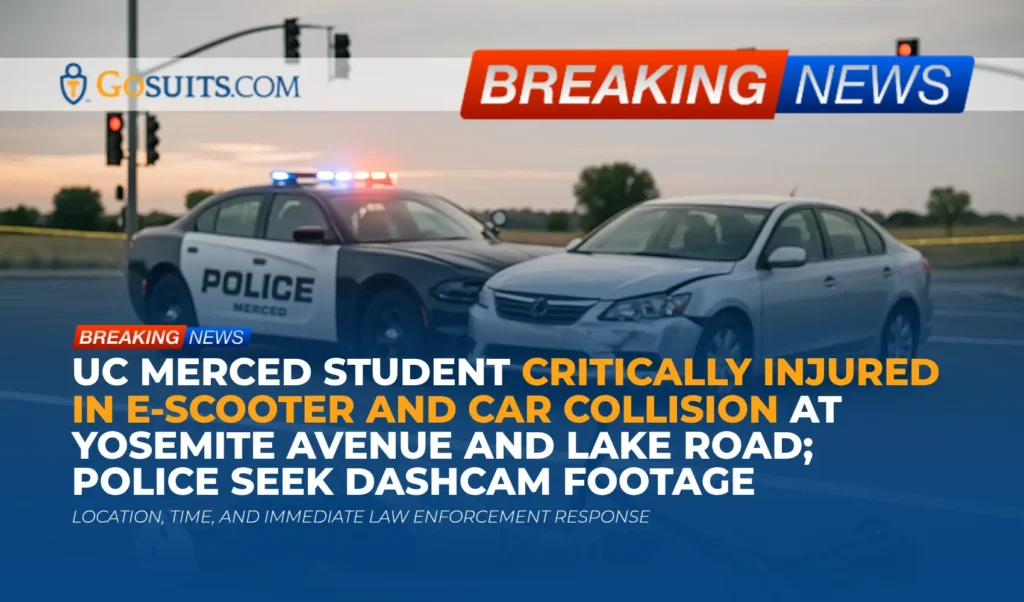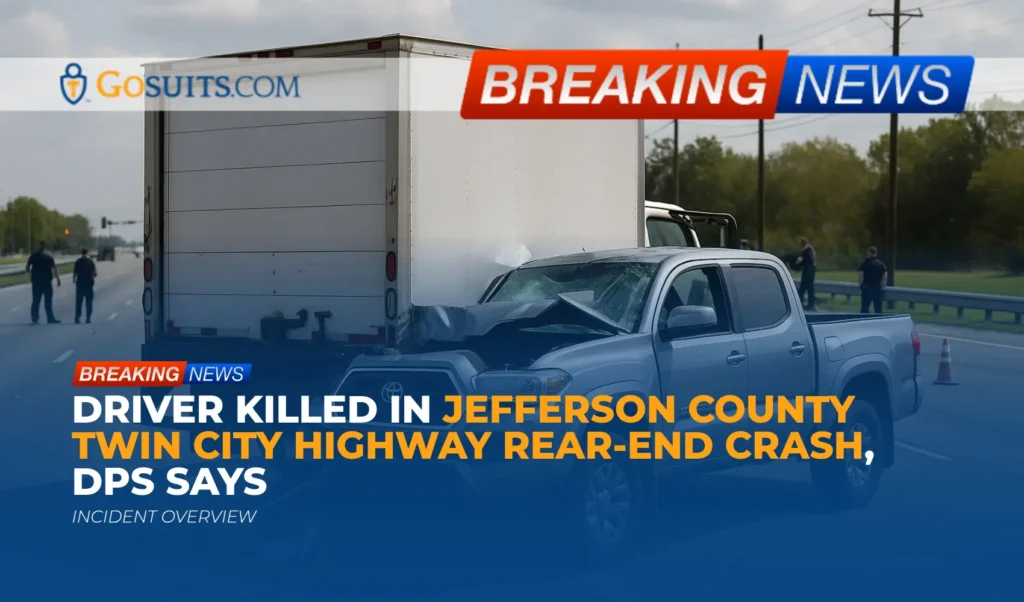- What we know so far about the Elk Grove fatal crash
- Roadway closure and location details
- Official statements and investigation status
- Understanding single-vehicle crashes and roadside hazards
- How to obtain official information and records
- Preserving evidence after a roadway death
- Potential civil liability in a single-vehicle fatal crash
- Insurance issues that commonly arise
- Time limits for California wrongful death and related claims
- Community safety considerations on Elk Grove Boulevard
- Helpful government resources
- Commentary from Gosuits Elk Grove, California Personal Injury Attorney
- Guidance: why acting now matters
What we know so far about the Elk Grove fatal crash
On the evening of October 19, 2025, a single-vehicle collision on Elk Grove Boulevard in Elk Grove, California, resulted in one fatality. Early reports indicate a white sedan left the roadway and struck a tree between Shorelake Drive and Waterfowl Drive, east of Interstate 5. According to statements at the scene, the sole occupant of the vehicle died there. The roadway was closed in both directions while investigators documented the scene and redirected traffic. The cause has not yet been identified, and authorities have not released further details about the person who passed away.
At this time, no contributing factors have been confirmed publicly. Investigators were seen photographing the vehicle and roadway area. This is a developing situation, and more information typically becomes available after initial scene work, next-of-kin notifications, and review of evidence such as vehicle data and any nearby cameras.
Roadway closure and location details
The closure affected Elk Grove Boulevard between Shorelake Drive and Waterfowl Drive. This stretch includes a slight bend and is landscaped with trees in the medians and along the corridor. While the closure has been used to preserve the scene for investigation and safety, reopening times were not immediately available. For those traveling in the area, law enforcement redirected traffic to nearby streets during the investigation period.
If traveling near Interstate 5, regional traffic updates for state highways are often available through Caltrans QuickMap. Local city street closures may not appear on state systems, but QuickMap can still help those connecting to or from the interstate.
Official statements and investigation status
Local police confirmed the following early facts:
- Crash type: Solo vehicle collision.
- Location: Elk Grove Boulevard between Shorelake Drive and Waterfowl Drive, east of I-5.
- Outcome: One person, the sole occupant, died at the scene.
- Status: Roadway closed during on-scene investigation; cause not yet determined.
In fatal collisions, investigators typically evaluate roadway conditions, vehicle condition, potential medical issues, and environmental factors. They may examine skid marks, debris fields, tree impact points, and vehicle damage patterns. When available, investigators can review nearby traffic cameras, private security cameras, and vehicle event data recorders.
Understanding single-vehicle crashes and roadside hazards
Single-vehicle crashes can occur for many reasons, including roadway departure, loss of control, sudden medical events, or vehicle failures. Collisions with fixed objects such as trees and poles are a known subset of roadway departure incidents. The Federal Highway Administration notes that roadway departure crashes account for a substantial portion of traffic fatalities nationwide, and mitigating these events involves roadway design, speed management, and forgiving roadsides where feasible. See FHWA’s overview on roadway departure safety and its discussion of clear zones and roadside safety.
Speed management also influences crash severity. The National Highway Traffic Safety Administration explains that higher speeds increase stopping distances and crash forces, raising the risk of serious injury or death. For context on the relationship between speed and fatal crashes, see NHTSA’s guidance on speeding and roadway safety.
While those general principles are widely recognized, each crash is unique. In a single-vehicle fatality, investigators may consider:
- Road design and conditions: Lighting, curve radius, signage, pavement surface, drainage, and roadside objects.
- Vehicle condition: Tires, brakes, steering, airbags, electronic stability control, and potential defects.
- Environmental factors: Weather, roadway debris, visibility, and low-friction surfaces.
- Medical or impairment-related issues: Medical emergencies or fatigue can sometimes precede roadway departures; authorities typically await coroner findings before any conclusions.
Event data recorders, when present, may retain short windows of pre-crash speed, braking, and other data. NHTSA provides background on these devices here: event data recorders. Access to EDR information often requires specialized equipment and, in some cases, consent or legal process.
How to obtain official information and records
Families and representatives often need official documents to understand what happened and to handle practical matters. The following are typical sources and how to approach them in Sacramento County and California generally. Processes can differ by agency, and timelines vary.
Police traffic collision report
Local police departments produce traffic collision reports that include diagrams, measurements, and officer observations. Because this crash occurred within city limits, the report is expected to be maintained by the municipal police agency that responded. Availability timelines vary, commonly several days to weeks.
California’s Public Records Act provides a framework for requesting records from public agencies. The California Department of Justice explains public access principles here: California Public Records Act overview. Traffic collision reports have privacy protections, and eligible parties may request them once available.
Practical tips:
- Have key details ready: date and approximate time, location (Elk Grove Boulevard between Shorelake Drive and Waterfowl Drive), and vehicle make/model if known.
- Identify your relationship: next of kin, legal representative, or insurer, as applicable.
- Ask about supplemental records: scene photos, measurements, and any citations or narrative supplements that may be releasable.
Coroner and autopsy reports
In Sacramento County, death investigations and autopsy/toxicology reports are handled by the Coroner’s Office. Families can obtain information about processes and requesting reports through the county’s official site: Sacramento County. Look for the Coroner’s Office page for instructions on how to request copies of reports and typical timelines. Autopsy and toxicology reports often require several weeks, depending on laboratory backlogs.
Death certificates and vital records
Certified copies of death certificates are generally obtained through county vital records or the California Department of Public Health. Guidance is available from CDPH here: California vital records. These documents are needed for estate matters, insurance claims, and certain benefits.
911 audio, dispatch logs, EMS and tow records
Some agencies maintain 911 audio and dispatch logs for a limited time. Requests may be made under the Public Records Act to the relevant agency. Emergency medical service run reports and tow records also exist and may be requested, though access can depend on privacy laws and agency policies. The Public Records Act overview provides general context for making requests to public entities.

Traffic and roadway data
If the incident occurred near a state facility like an interchange, Caltrans may have traffic data, camera archives, or maintenance records relevant to state-managed infrastructure. For broad traffic conditions across state highways, see Caltrans QuickMap. City-managed footage or data would typically be requested from the city under the Public Records Act.
Preserving evidence after a roadway death
Key evidence can be lost quickly. Families often benefit when a representative promptly coordinates preservation of vehicle and scene evidence. Steps can include:
- Vehicle preservation: Ask the tow yard in writing to hold the vehicle without alteration until an inspection can occur. This helps preserve the event data recorder, airbag control modules, and physical evidence such as tire condition and impact points.
- Notice to preserve evidence: A written preservation notice to involved entities (tow operators, insurers, potential custodians of camera footage) can help prevent routine deletion or disposal.
- Identify potential video sources: Nearby businesses, residences, or traffic cameras may have recordings. Many systems overwrite within days.
- Document the area: Photographs of signage, lighting, road markings, and roadside objects can be useful if taken safely and lawfully.
- Secure records: Request police reports, coroner records, dispatch logs, and any available data promptly, understanding some documents are released only after the investigation reaches certain milestones.
Because insurers also begin their own investigations quickly, speaking with a seasoned attorney before contacting any insurance company can help protect rights. What someone says to an insurer can be recorded and later used to shape the claim.
Potential civil liability in a single-vehicle fatal crash
Even when only one vehicle is involved, various parties can bear civil responsibility depending on the facts. No conclusions should be drawn until the investigation is complete, but these are common avenues considered in civil claims arising from similar events:
- Vehicle design or component failures: Tires, steering, airbags, brakes, and stability systems can contribute if they fail. Vehicle recalls or defect investigations may be relevant.
- Roadway design or maintenance: Signage, lighting, pavement condition, drainage, and roadside object placement are considered. The FHWA discusses the concept of “forgiving roadsides” and clear zones, which aim to reduce the severity of run-off-road crashes when feasible.
- Contractors and property owners: In some cases, work zones, landscaping, or adjacent property features can affect roadside safety if not installed or maintained according to applicable standards.
- Employer responsibility: If the driver was performing work duties, employers may be implicated under principles of vicarious liability. Confirmation requires employment and trip-purpose records.
- Phantom or contributing vehicles: A driver may crash while avoiding another vehicle that leaves the scene. In such situations, uninsured motorist coverage analysis can become important even without direct impact, depending on the policy language and corroborating evidence.
Where a public entity’s roadway design or maintenance is implicated, California’s Government Claims Act imposes specific procedures and shorter deadlines before a civil suit can be filed. In most circumstances, a written claim must be filed within six months of the incident. See Government Code § 911.2. Public entities may assert defenses such as design immunity, but each case turns on its facts and documentation.
Insurance issues that commonly arise
Insurance questions after a fatal crash can be complicated. Policies differ, and careful review is needed before making statements or submitting forms. The California Department of Insurance offers consumer information on auto coverages here: Auto insurance basics.
- Liability coverage: Pays claims to others when the insured is legally responsible. In single-vehicle fatalities, liability questions may still arise depending on defects, roadway issues, or involvement of other parties.
- Medical Payments (MedPay): Optional in many policies; can help with certain medical or funeral expenses regardless of fault, up to policy limits.
- Uninsured/Underinsured Motorist (UM/UIM): May apply if another vehicle contributed and is unidentified or inadequately insured. Corroborating evidence is often essential for UM claims involving a non-contact “phantom vehicle.”
- Property damage and towing: Policies commonly cover vehicle damage based on actual cash value, but total losses, storage, and salvage rights can create disputes. Preserve the vehicle until evaluations are complete.
Before speaking with any insurer or giving recorded statements, it is prudent to consult with an attorney to understand rights and potential consequences. What is said to an insurance adjuster can affect coverage decisions and future claims handling.
Time limits for California wrongful death and related claims
California imposes time limits for bringing civil actions. Missing a deadline can bar a claim, so calendar these early and verify any circumstances that shorten or extend them.
- Wrongful death: Generally two years from the date of death. See Code of Civil Procedure § 335.1.
- Survival actions: Brought by the decedent’s estate to recover certain damages the person could have sought if they had lived. See Code of Civil Procedure § 377.30.
- Who may bring a wrongful death claim: Spouse, domestic partner, children, or others who can show they were financially dependent, as defined by statute. See Code of Civil Procedure § 377.60.
- Claims against public entities: Typically require a government claim within six months. See Government Code § 911.2.
There are exceptions and special rules in certain circumstances, so individualized guidance is important.
Community safety considerations on Elk Grove Boulevard
Community members often ask how similar crashes can be prevented. Safety is a shared responsibility across roadway design, operations, and driver behavior. FHWA’s materials on roadway departure and speed management highlight strategies used by transportation agencies, including improved curve signage and delineation, high-friction surface treatments in curves, targeted lighting, and access management.
Trees and aesthetic landscaping can enhance communities but may pose severe risks when located close to the lane edge without protective measures. FHWA’s clear zone principles encourage “forgiving roadsides” where possible, balancing mobility, safety, environment, and community character. In built-up corridors, agencies sometimes use measures such as barriers, reduced speeds, enhanced delineation, and enforcement to mitigate risks.
In fatal investigations, it is common for traffic engineers to review crash history along a segment to determine if additional countermeasures are warranted. This can include evaluating curve radius, advisory speed plaques, chevrons, reflectorized markers, and friction treatments. Residents can also participate in public meetings and provide feedback to local transportation departments as improvements are considered.
Helpful government resources
- California Public Records Act (CPRA): How to request records from public agencies, from the California Department of Justice.
- California Department of Public Health: Guidance on obtaining death certificates and vital records at CDPH Vital Records.
- Sacramento County: County portal with links to departments including the Coroner’s Office at saccounty.gov.
- NHTSA Speeding information: Risk factors and national data at NHTSA.
- FHWA Roadway Departure and Clear Zones: Engineering strategies and safety concepts at FHWA Roadway Departure and FHWA Clear Zones.
- Caltrans QuickMap: State highway traffic conditions at quickmap.dot.ca.gov.
- California Department of Insurance: Consumer auto insurance basics at insurance.ca.gov.

Commentary from Gosuits Elk Grove, California Personal Injury Attorney
Our hearts are with everyone affected by this tragic loss on Elk Grove Boulevard. Sudden, life-altering events like this send shockwaves through families and neighborhoods. This article is intended for general information and to help the community understand typical next steps and issues that arise after a fatal crash.
From a civil injury perspective, a “single-vehicle” label does not end the inquiry. Careful evaluation often looks beyond the immediate impact to examine vehicle integrity, potential defect patterns, roadway design and maintenance, roadside object placement, signage and lighting, and whether any other road user’s actions contributed. Investigators, engineers, and reconstruction specialists typically work from physical evidence, data recorders, and official reports to reconstruct the sequence.
Insurance companies and large corporations have significant resources and processes designed to protect their financial exposure. Adjusters can move quickly to obtain statements, inspect vehicles, and influence the narrative. It is common for people to feel pressured to answer questions or accept early decisions before the full picture emerges. Without guidance, families may inadvertently limit the scope of the investigation, allow key evidence to be lost, or agree to terms that do not reflect the true extent of loss.
A free consultation with a seasoned attorney can help clarify rights, identify time-sensitive steps, and prevent avoidable missteps. Early advice can be the difference between a thorough, documented record and one that leaves critical questions unanswered.
Guidance: why acting now matters
Below is practical guidance for anyone seeking to protect their options after a serious roadway loss. This is general information and not a substitute for individualized counsel.
- Preserve the vehicle immediately: Ensure the vehicle remains intact and unaltered. Event data recorders and physical evidence can be lost if a vehicle is released, repaired, or salvaged too soon.
- Send preservation notices: Promptly request that tow yards, insurers, and any potential custodians of video or telemetry preserve relevant evidence. Many systems overwrite within days.
- Request official records: Start the process for police reports, coroner documents, and dispatch logs. Expect staggered timelines; some materials are released only after investigative milestones.
- Avoid recorded statements to insurers before counsel: Conversations with adjusters are often recorded and can affect coverage and liability determinations later. Consult an attorney first.
- Identify all potential coverages: Review auto, umbrella, MedPay, UM/UIM, and any employer policies that may apply. Keep policy numbers and declarations pages organized.
- Calendar legal deadlines: Note the two-year general deadline for wrongful death claims and the six-month claim requirement when public entities may be involved. Missing these can foreclose options.
- Track expenses and losses: Keep receipts, funeral invoices, travel costs, and any documentation of lost financial support. Accurate records support a full accounting of loss.
- Limit social media: Public posts can be reviewed by insurers and opposing parties. Consider pausing or restricting sharing about the incident.
- Consider an independent inspection: A qualified reconstruction and vehicle inspection can complement official investigations and identify issues not captured in standard reports.
- Stay patient but proactive: Autopsy, toxicology, and some engineering analyses take time. Continued follow-up, while preserving evidence and meeting deadlines, protects longer-term interests.






